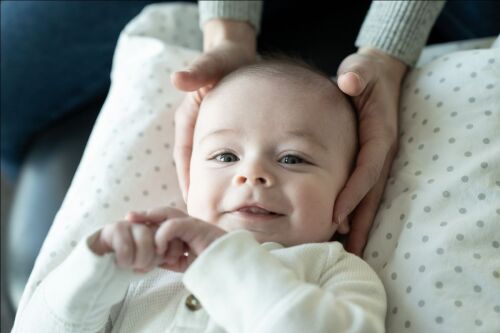
Congenital muscular torticollis, which is also called twisted neck or wryneck is a condition in which an infant holds his or her head tilted to one side and has difficulty turning the head to the opposite side.
This can be a result of a tight or shortened muscle that extends down the side of the neck—the sternocleidomastoid muscle.
What Causes Congenital Muscular Torticollis?
The cause of congenital muscular torticollis is unknown, however, it may be related to an abnormal in-utereo positioning (breech position, for example) or “crowding” of the baby while in the uterus. This results in an injury to the neck muscle that scars as it heals. The amount of scar in the muscle determines how tight the muscle is.
Congenital muscular torticollis may also occur following a difficult birth, especially if the infant is delivered breech. During the delivery, if the sternocleidomastoid muscle is stretched or pulled, it may tear, causing bleeding and bruising within the muscle.
The injured muscle develops fibrosis (scar tissue) which causes the muscle to shorten and tighten, pulling the infant’s head to one side. The fibrosis forms a mass or lump that sometimes can be felt on the side of the neck.
Congenital muscular torticollis is usually discovered in the first 6 to 8 weeks of life when a newborn begins to gain more control over its head and neck and odd positioning or head placement is seen.
Symptoms of Congenital Muscular Torticollis
The following are the most common symptoms of congenital muscular torticollis:
- Consistent tilting of the infant’s head to one side.
- Firm, small, soft lump in the middle of the sternocleidomastoid muscle.
- The head tilts to one side and the chin points to the opposite shoulder. In 75% of babies with torticollis, the muscle on the right side of the neck is affected.
- Limited range of motion in the neck makes it difficult for the baby to turn its head side to side, and up and down.
- One side of the face and head may flatten because the child always sleeps on one side.
- An infant looks at you over one shoulder instead of turning and following you with their eyes
- If breastfed, the infant has trouble breastfeeding on one side or prefers one breast.
- Baby works hard to turn toward you and gets upset when they are unable to turn their head completely.
Diagnosis of Congenital Muscular Torticollis
A physical examination of the infant may show the characteristic tilting of the head and tension of the sternocleidomastoid muscle, as well as the presence of a palpable lump in the middle portion of the muscle.
A complete medical history including in-utereo and birth history as well as other diagnostic modalities may be utilized to confirm a definitive diagnosis.
Treatment for Congenital Muscular Torticollis
The standard treatment for congenital muscular torticollis consists of regular and consistent exercise to stretch the affected sternocleidomastoid muscle.
These stretching exercises include turning the baby’s neck side-to-side so that the chin touches each shoulder, and gently tilting the head to bring the ear on the unaffected side down to the shoulder.
These exercises must be done several times a day. A doctor, chiropractor, or physical therapist can show you how to perform the exercises.
There are other things that you can do at home to help:
- Place toys where your baby must turn his or her head to see them.
- Carry your child so that he or she looks away from the limited side.
- Position your crib and changing table so that your child must look away from the limited side to see you.
- Lay your baby on his or her stomach for brief periods when awake (“tummy time”) to help strengthen their neck muscles.
How Chiropractic Care Can Help Patients with Congenital Muscular Torticollis
Chiropractic management of torticollis is gentle and specifically tailored to each of our little patients. If you can restore some movement in the cervical spine, where subluxations are commonly present with this diagnosis, you can often coax the muscles to ease and relax on their own.
Vaida’s Dr. Lydia and Dr. Emily love working in conjunction with physical therapists on torticollis cases and often see faster + better results in babies when both chiropractic care and physical therapy are used simultaneously! We have our own resident PT Dr. Natalie on our Vaida staff.
If your wee one is exhibiting symptoms of congenital muscular torticollis or if he/she has been diagnosed with it, please schedule an appointment with our Vaida specialists.
